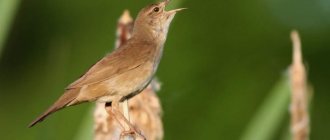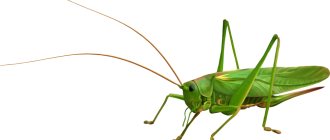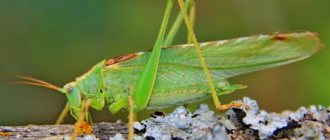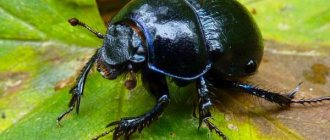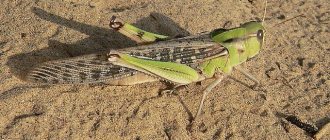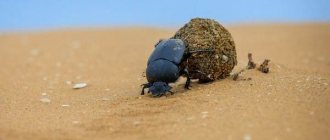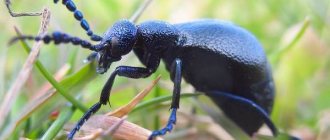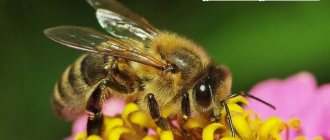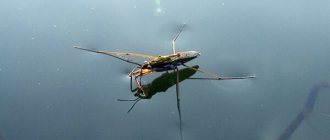- Wild animals
- >>
- Insects
A curious little insect, which, on the one hand, can be unpleasant to the human eye, but on the other hand, delight our ears with its melodic sound. When we walk in a park or forest clearing in warm and dry summer weather, we hear hundreds of unusual “bugs” making sounds with different timbres and frequency, proudly called crickets .
Origin of the species and description
Photo: Cricket
In our nature, there are several species of crickets from the family of “true crickets”, the Latin name of which is Gryllidae:
- Far Eastern stem cricket (Oecanthus longicaudus) - they can be found in Japan, China and the Russian Far East. The second name of the insect is “eastern trumpeter”.
- The field cricket (Gryllus campestris) is a species of orthoptera cricket. They are found more often in the countries of Asia Minor and Western Asia, Southern and Central Europe, and in African countries. They mainly prefer sunny meadows and fields, open places under the sun, light pine forests, and any open areas under the sun.
- House cricket (Acheta domesticus) - like the field cricket, belongs to the species of orthoptera crickets. This insect settles during the cold period in human dwellings, in any warm rooms, heated industrial buildings, basements, etc. With the onset of warm spring and until the warmest autumn, they leave the premises and other outbuildings into nature. The second name is house cricket.
There are also ant crickets, otherwise they are called “common ant-loving”. Belongs to the order of Orthoptera insects and a species of small ant crickets. They are also called ant-loving crickets. Small and wingless insects. They are considered the smallest of all cricket insects. The closest relatives of crickets are grasshoppers and locusts.
Prevention measures
Following simple rules will save the owners from the appearance of annoying “singers” in the house:
- attach a mosquito net to the windows;
- cover all cracks in doors, window frames, floors;
- close the trash can tightly, remove crumbs and leftover food from the table;
- prevent dampness in rooms;
- warn sanitary services and management company employees about the accumulation of water in the basement;
- double your vigilance when living on the lower floors: basement dwellers (crickets) often climb into your home if there are holes or cracks in the floor or baseboards near the sewer pipes;
- illuminate the yard with medium-power lamps, the best option is yellow light;
- cover the ventilation grilles with a mesh with small cells;
- compost heaps and a scattering of sawdust should be located at a distance from a private house, in the far corner of the site;
- trim greenery near the house, avoid planting close to the structure of climbing plants;
- In the evening, close the blinds and draw the curtains: bright light attracts insects.
If preventive measures are taken, the night “singers” from the order Orthoptera will not disturb sleep. If a cricket has entered the house, it is important to get rid of the insect before several individuals take up residence in the home. If annoying “neighbors” are actively multiplying and disturbing the peace of household members, you will have to carry out independent treatment with insecticides or call sanitary workers for disinfestation.
Cricket in the house: well-being or sleepless nights? Useful information in the following video:
Attention! Only today!
True crickets are a family of more than 2,000 species. The most common of them live in the European part of Russia - field and brownie. In everyday life they are called garden and home. They prefer not to show themselves to humans, so few people know what a cricket looks like, but summer residents regularly listen to the chirping of this insect.
Appearance and features
Photo: Cricket insect
All crickets are quite small in size, but still differ in their appearance depending on which group the insect belongs to.
House cricket, up to approximately 24 mm in size. There are eyes on both sides. “The antennae on the head are longer than their body, which serve the function of touch.” The body is covered with a special substance called chitin. It helps the insect protect itself from harmful environmental factors and also prevents water loss.
Video: Cricket
The color is gray-yellow, and the body itself has streaks of brown shades. They have wings that help them move at high speed. When folded, the wings protrude beyond the body itself and resemble a long tail. House crickets do not use their wings.
They have three pairs of limbs, the back pair is longer, so thanks to them the cricket can move quickly and over long distances. The front pairs of paws act as hearing organs. The back part of the body is called the “ovipositor”. Females and males have them, but they differ in size. In females, the ovipositor is longer - approximately from 1 to 1.4 cm, in males it is 3 - 5 mm less.
The field cricket differs from the “domestic” cricket in its impressive size. The size of an adult is up to 2.5 cm. The body is black with brown shades, and covered with gloss. The head is oval with eyes and antennae. Otherwise, the “field bug” is similar to the brownie cricket.
The eastern trumpeter grows up to 1.3 cm. Compared to its counterparts, it is much smaller. The stem cricket received its name due to the fact that it lays clutches of eggs in the plant stems themselves. The second name, “eastern trumpeter,” was given because of its origin (the Far East).
In color it is distinguished by its brown flowers, with shades of green. Also long antennae, 3 pairs of legs, the hind ones of which are the most powerful, wings and elytra are transparent. The elongated body somewhat resembles a grasshopper. Ant crickets are the smallest, up to 5 mm. They do not have wings, and their appearance resembles domestic cockroaches.
How to get rid of it: methods of struggle
The first thing that comes to mind is to catch a cricket. Despite the apparent simplicity of the method (you can clearly hear where the sound is coming from), it is difficult to implement the idea. Insects sense air vibrations well, their hearing is sensitive, and it is difficult to get closer than three or four steps to the “singer.” Owners have to use other, more effective methods.
Crickets destroy small pests, for example, but constant night “concerts” and insomnia among residents neutralize the benefits of living close to humans.
Sticky traps
A device with a sticky surface will help you catch the cricket. Place adhesive tape in areas where night singers have been spotted. For greater efficiency, it is advisable to buy several products to catch annoying insects. Adhesive tape is inexpensive and gives noticeable results.
Important!
When breeding “singing” insects, traps alone are not enough: toxic aerosols and mechanical removal of ovipositions will be needed.
Folk remedies and recipes
To scare away annoying “singers”, compositions based on medicinal plants are suitable:
- wormwood decoction.
For a liter of water you will need 2 tbsp. l. chopped leaves and stems. Boil the mixture for 5 minutes, close the lid, remove from heat, and let it brew for two hours. Pour the strained product into a spray bottle and spray the baseboards, floors, walls, window sills, window frames; - pyrethrum powder.
The herbal remedy does not harm people or pets. Owners often use a special variety of chamomile to repel harmful insects. Crickets also cannot tolerate the characteristic odor of the plant. Sprinkle pyrethrum powder over areas where annoying “troublemakers” have been spotted.
Chemicals
Toxic drugs will be needed if the insects have managed to lay eggs. Compositions based on Dichlorvos - varieties Super, Neo, Varan - are suitable for killing crickets. A universal product with or without scent has a detrimental effect on adult insects. Repeated treatment of the premises helps to destroy individuals that have hatched from eggs.
Disinsection rules:
- put on a protective suit, plastic transparent glasses, a respirator, protect your hands with gloves;
- the can of Dichlorvos is ready for use;
- close all doors and windows, remove household members from the apartment. Pets and an aquarium with fish are also not needed during the treatment;
- shake the can several times and begin disinfestation;
- Treatment is carried out in areas where crickets have been observed. Be sure to spray the composition on doors, window sills, corners, window frames;
- the optimal distance to the surface is 25–30 cm. Carefully go through all areas, spray the composition into the cracks, behind the baseboards if they lag behind the walls;
- keep the container with the toxic composition at arm's length so that the fumes do not get on your face;
- after disinfestation, leave the premises;
- return after 6 hours, open the windows, pick up dead insects;
- mandatory stage - airing for half an hour;
- All that remains is to collect the egg deposits from the baseboards and in the corners with a vacuum cleaner with a disposable filter, and do wet cleaning;
- re-treatment of the apartment is carried out after 40–70 days. During this period, adult insects emerge from eggs that remain undetected;
- After destroying the crickets, owners should think about how to prevent the reappearance of annoying “singers” in an apartment or house. The “Prevention Measures” section describes available ways to protect your home from insects.
How to deal with? Check out a review of effective chemicals and recipes for folk remedies.
Where does the cricket live?
Photo: Cricket in the grass
The habitat of “house” crickets is in areas with a warm climate in the summer months: green fields, meadows, open forest glades, pine groves under the sun. They dig a hole for themselves with their jaws, in which they subsequently take refuge during periods of bad weather or danger. When they leave their shelters, carefully covering it with grass, they go in search of food.
With the onset of cold weather, the house cricket seeks shelter in house outbuildings, and in any dwellings where there is warmth. They do not live in apartments, not counting the first floors of old houses. Field crickets live only in warm regions, in meadows, fields and forests. They dig their burrows in loose and oxygenated soil, 15 to 25 cm deep. These burrows are considered their shelter. During periods of cold weather, it overwinters as a larva and imago (in the adult insect stage).
Females can leave their burrows in search of a partner, leaving him covered with a bunch of grass, but males will not abandon their shelter. Rather, on the contrary, they protect him from their relatives and engage in battle if necessary. It is not uncommon for field crickets to die for their “house.” For most of its existence, the field cricket lives on the soil surface.
The common stem cricket lives in the territories of the Far East, steppe Russia, southern Siberia, the Caucasus and Kazakhstan. Prefers to settle in plant stems, bushes, and foothills. Waits out bad weather under leaves on the ground.
Ant crickets live in the warm countries of America. They live near ant nests. And they wait out the cold periods from October to March in the anthills themselves in the adult and larval stages. This species can be found in Western and Eastern Europe, they were found in Russia and Ukraine, there is information about finds in Italy and Romania.
Folk signs
A single cricket in the house does not pose a danger - it does not spoil food and does not bite. There are many signs associated with him. Some of them promise changes for the better. There are also those who warn of danger: flying around a house or bathhouse, a cricket anticipates a fire.
Our grandmothers did not wonder how to get rid of crickets in the house. They believed that soon after he sneaks behind the stove, the unmarried girl should wait for the groom. Pregnancy and childbirth will be easy, and the patient will be cured. But killing a cricket meant inviting misfortune upon yourself.
What does a cricket eat?
Photo: Insect cricket
The cricket's diet is very varied. In their nature, they all feed on plant foods: roots and leaves of plants, fresh shoots of grass, leaves of shrubs. They prefer young seedlings, especially adult ones. Field crickets are omnivores, and since they need protein in addition to plant foods, they also feed on small ground corpses of invertebrate insects.
House crickets also eat leftover food left by humans. But greater preference is given to liquid food at home. Small invertebrates also eat soft and corpse tissues of insects. “Domestic insects have such a concept as cannibalism. Adults can eat young animals and larvae that have not yet reached sexual maturity.”
Specially grown crickets are fed plant foods that are always rich in proteins. The diet contains: leftover fruits and vegetables, bread crumbs and other cereals, tops and leaves from the garden, as well as fish and egg meal. But most importantly, they need liquid, which is best given in the form of a sponge soaked in water. Such crickets are specially raised at the Moscow Zoo to feed their charges.
This is a harmless insect; they do not bite and do not show aggression towards the surrounding world and humans. All their hostility can only manifest themselves towards their rival who has entered his protected territory. Therefore, you should not be afraid of him.
But there are times when, due to an overpopulation of crickets in an area, the harvest may be lost. This is the exception rather than the rule, but cases have occurred. And under certain weather conditions, a cricket can reproduce very quickly and “a lot.” Then special tools will come in handy as assistants to help get rid of uninvited guests.
What are they eating?
Their diet is varied. But mainly it consists of the food described below.
Dead insects. If they find dead insects, they will eat them. The less intense the prey hunt, the better for crickets.
Mushrooms. Since they spend a lot of time around wooden piles and in damp conditions, they encounter fungi. Why not eat them, because they are motionless and you don’t need to waste energy on hunting?
Plants. Leaves, stems and seeds are good food for these insects.
Fruits. This applies to fruit that has fallen from a tree or is in your home. If they have access to something sweet and soft, then they will like it.
Cloth. Yes, they even eat clothes. If you leave it on the floor in your home or outside for a certain period of time, you may notice the damage caused. They don't care when they're hungry. They will eat silk and even wool.
Other crickets. If there is no food around, they will begin to hunt for cannibalism.
Paper. They eat paper products. Naturally, if there is nothing tastier nearby.
Leather. They also eat leather products. They will chew on leather sofas, wallets, bags, etc. Therefore, if such “guests” appear in your house, it is better to hide any leather items.
Features of character and lifestyle
Photo: Cricket
The most striking feature that a cricket has, and why people sometimes breed them at home, is its melodic sounds. They produce unique, special and melodious signals. Moreover, such “melodies” are produced exclusively by sexually mature males. There are three types of signals. Each sound has its own meaning. Some signals encourage the female to mate, while others scare away potential female suitors. And still others emit signals when courting a partner in order to attract her.
How do crickets make sounds? On the right wing of the “bug” there are special chirping cords, which in turn rub against the left wing. This is how the chirping sound of a cricket comes about. And the raised wings serve as a sound resonator. Their wings create more than 4,000 vibrations per second. Thus, the signals are very clearly audible to humans. Crickets chirp all summer long, and you can clearly hear it while outdoors.
“In the old days, it was believed that if a “screaming” cricket lives in a house, it brings good luck to the owner and protects him from evil and disease. For the pregnant girls living in the house, this meant an easy birth. And we shouldn’t have gotten rid of them.” Today everything is different, not many people like such “vocalists”, some simply disdain insects, and for others such singing interferes with sleep.
This insect loves warmth very much; without it, their process of reproduction and development slows down, and they become inactive. And if the temperature reaches sub-zero temperatures, the insect simply goes into hibernation.
By the way, in some Asian countries, crickets are eaten and are considered a delicacy. Many visiting tourists are offered to taste this insect during excursions to markets.
Crickets have a special way of life - one male has a certain part of the territory that he controls. Can attract many females, whom he will consider only as his own. Something like a harem. But God forbid another male gets into his territory - a fight will break out in which only one individual will survive. And the male who wins can dine on his rival.
The Chinese, taking advantage of their lifestyle of competition between males, organize field cricket fights. The winning cricket in the duel receives a “reward”.
Sounds
In the East, crickets were kept at home for the sake of their singing, just like birds. The best warblers are Indian (palm) and two-spotted crickets. Only males sing. The loss of even one wing leads to the male losing the ability to make sounds, which makes him unsuitable for reproduction: females are not interested in such a male.
Young male crickets do not sing very musically; they are still learning, imitating their elders. When threatening an opponent, males tut sharply, which is perceived by humans as an annoying chirping. The most complex and pleasant song for the female, it sounds quiet but melodious, and includes ringing and buzzing trills. In addition, the male performs a courtship dance, spins around in front of the female, and taps her on the back with his antennae. Several females live in the territory of one male, and he vigilantly watches them, not letting them leave the boundaries of the area. But sometimes females move from male to male, attracted by a special high-pitched song designed to lure other females and return their own. In captivity, crickets sing during the day.
Males make sounds by rubbing the chirping cord at the base of one elytra against the teeth on the surface of the other. When the trembling bases of the elytra are raised upward, a sharp vibrating movement occurs. This is what causes sound.
| Cricket chirping |
| Sounds made by a house cricket |
| Voice (sound) of a cricket |
| Cricket chirping |
Social structure and reproduction
Photo: Field cricket
All insects go through three stages in their life cycle: egg, larva and adult (otherwise known as imago). But the process of reproduction of crickets in each species differs in terms of development, number of stages and life expectancy:
Field crickets sing “serenades” at the entrance of their burrows, calling for females to mate. After the mating process, females lay up to 600 eggs in the soil. Larvae appear after 2.5 - 4 weeks. This occurs at the very end of spring or beginning of summer. After the larvae hatch from the eggs, they immediately moult and become like wingless little bugs that can only crawl on the ground.
They grow very quickly and can molt up to 8 times throughout the summer. As soon as the cold weather sets in, they hide in their burrows dug with their jaws. In houses, after 1 - 2 molts, they turn into an adult (imago). And as soon as they feel the warmth coming, they crawl out as adults and again prepare to reproduce. After laying eggs, the female dies by the end of summer. Life period – up to 1.5 years.
The common cricket lays its eggs in moist cracks in the soil. One female can lay up to 180 eggs per season, but at high temperatures, from +28 and above, she can lay 2–3 times more. After a week and up to 3 months (depending on weather conditions - the warmer it is, the faster the emergence occurs), the nymphs hatch, also wingless. They go through 11 stages of development to adulthood. The duration of the “domestic” imago is up to 90 days.
The principle of mating and laying eggs of the stem cricket is similar to the previously described methods. And life expectancy is approximately 3 – 4 months. Much depends on climatic conditions and the habitat of this species.
The cycle of laying eggs until the full development of an adult ant cricket is 2 years. The longest of all types. And the process itself consists of 5 stages, which takes place in anthills. Life expectancy is up to six months. “This type of cricket is not capable of singing, so mating takes place without courtship and a long search for “suitors.”
Farm at home
Breeding crickets
There is also the opposite side of the coin. Fishermen and reptile lovers are often forced to independently breed these insects at home in terrariums. Not every reptile agrees to eat frozen dead food, and the cost of such food in a pet store can ruin lovers of rare animals.
On a note!
These insects do not have seasonal activity, therefore, given favorable conditions, the house cricket is able to reproduce all year round. This is very helpful for terrarium owners.
The optimal combination of insects is 1 male to 5 females. When there is an overabundance of males, fierce fights arise between them, which leads to injuries among the breeders. A male that has lost its elytra is unable to produce mating trills and becomes unsuitable for breeding.
Females are provided with a moist substrate for laying eggs. Containers with the substrate are covered with a mesh with a mesh size of 2 mm. The net is needed to prevent insects from digging up and eating the eggs. In favorable home conditions, the female lays 200-500 eggs, shaped like a banana.
Important!
The substrate should not be too dry or dense. When attempting to lay eggs in dense or dry soil, females damage the oviduct and become unable to reproduce.
The humidity of the substrate must be carefully monitored. When dry, the white eggs dry out and become transparent. This means the death of the masonry. In the case of a dry substrate, the female may try to lay eggs in the drinker. In this case, the masonry will also die.
The house cricket is an insect with an incomplete metamorphosis cycle. There are only three stages in its development:
- egg;
- nymph;
- imago.
The pupal stage is eliminated. The nymph is very similar to the adult, but lacks wings. The nymph has 9-11 stages of development. That is, young domestic crickets will molt 9-11 times.
At home, egg development lasts 10 days, so containers with substrate must be replaced every decade. The fry that emerge from the eggs must be fed with soft protein food, placing the food in a container with low sides. You also need to provide young domestic crickets with water. Wick drinkers are suitable for this.
Depending on the room temperature, the development of house crickets lasts 40-60 days or more. After completing the development cycle, they are suitable for feeding domestic reptiles.
Natural enemies of crickets
Photo: Cricket
Crickets don't have many enemies. Partly this is a person, since with a large overpopulation of insects, he will begin to fight them. Since no one wants to lose their harvest, people begin to fight crickets using chemicals. This does not happen in our middle zone, since in order for a large number of them to breed, a tropical climate is needed, which we do not have.
Man uses cricket as bait to catch rare fish species. But in some Asian countries they are eaten. In other countries, the insect is used as food for animals - reptiles that live in the house as pets. Since crickets are rich in proteins and proteins, they are considered a valuable food product.
Interesting fact: in 2022, one newspaper talked about an American company in Texas, which was the very first to produce fried snacks consisting of crickets in five flavors: sea salt, barbecue, sour cream and onion, etc. The snacks were then positioned as protein and protein foods .
Relationships with a person
Cricket
A very difficult topic for cricket. In Japan, it was customary to keep these insects at home in miniature cages. In Asia they are specially bred for food; in North America they are used as bait. In Russia today, many exotic animal lovers keep reptiles that eat crickets. Owners of these cold-blooded animals, along with reptiles, usually breed crickets as food for their pets.
If a cricket suddenly appears in a multi-storey building in the city center, you can be sure that it has escaped from a pet reptile lover. Much less often such escapes occur from insect lovers due to the fact that they also prefer to keep exotic crickets.
On a note!
There is nothing to worry about if this insect has settled in your home. Although it is related to cockroaches and can feed on similar foods, it does not cause any damage. Night Grasshopper is neutral. It does no harm or good. Except for nighttime singing, which can interfere with sleep.
Lifestyle
The house cricket is active at night and twilight, and during the day it hides in various shelters. It digs holes in the ground, where it hides in case of danger. The territory of each cricket occupies several tens of square centimeters; the owner of the site regularly walks around his property and drives out strangers. If two males meet nose to nose, a fight cannot be avoided. Crickets tend to bite off the enemy's antennae, or even paws. The fight may end in the death of one of them, in which case the winner can eat the loser. But usually a bitten mustache is enough to stop the fight. The male who has lost his mustache runs away, since crickets without mustaches cannot occupy the highest places in the hierarchy; they turn into outcasts. Crickets do not have a specific overwintering stage, but they can survive cold weather in and around buildings and in landfills, where they can be warmed by the heat from fermentation.
References:
- Gorokhov, A.V. Life forms of crickets (Orthoptera, Grylloidea) of Central Asia / Gorokhov A.V. // Entomol. review – 1979.- T.58, No. 3.- P.506-521.
- Gorokhov, A.V. On the morphological criteria of the genus in crickets (Orthoptera, Grylloidea) / Gorokhov A.V. // General entomol. – L.: Science – 1986. – T. 68. – P. 17-19.
- Zhantiev, R.D. Bioacoustics of insects / R.D. Zhantiev. – M.: Publishing house Mosk. University, 1981. – 256 p.
- Zhuravlev, Yu.D. Insect cultures used for feeding amphibians and reptiles in the terrarium of the Almaty Zoo / Zhuravlev Yu.D., Pugacheva N.A. // Scientific research in zoological parks. – M., 1994. – Issue. 4. – pp. 110-111.
- Knyazev, A.N. Developmental cycle of the cricket Gryllus bimaculatus Deg. (Orthoptera, Gryllidae) under laboratory conditions / Knyazev A.N. // Entomol. review – 1985. –T.64, Issue 1. – P. 58-74.
- Yasyukevich, V.V. Cultivation of crickets for feeding exotic animals / Yasyukevich V.V., Rivkin L.E. .// Scientific materials - practical conf. Animal culture and biological resources. – M.: Scientific T. ed. KMK., 2005. – pp. 146-148.
- Alexander RD The evolution of genitalia and mating behavior in crickets (Gryllidae) and other Orthoptera / Alexander RD, Otte D. // Misc. Pabl. Mus. Zool. Univ. Michigan. – 1967. – Vol. 133. – R. 1-62.
- McFarlane JE Studies on group effects in crickets / McFarlane JE // Can. J Zool. – 1984. – Vol. 44. – P. 1017-1021.
- Wineriter SA Group and individual rearing of field crickets (Orthoptera: Gryllidae) / Wineriter SA, Walker TJ // Entomol. News. – 1988. –Vol. 99, No. 1. – P. 53-62.
- Wyniger R. Insektenzucht / R. Wyniger. – Stuttgart: E. Ulmer Verlag, 1974. – 368 rub.
